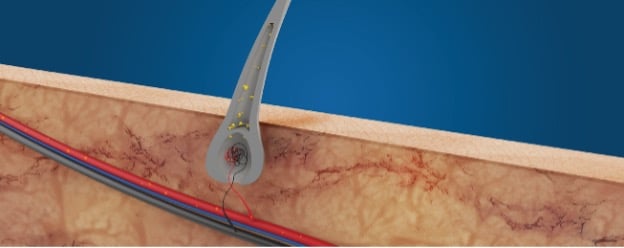Hair testing has gained widespread recognition as a remarkable scientific method for detecting various substances like drugs, alcohol, environmental contaminants, and nutritional indicators. In this guide, we’ll explore the fascinating science behind hair testing, looking at how it works, what makes it precise, how it has evolved, and its diverse range of uses.
The Basics of Hair Growth

Understanding how hair testing works starts with comprehending the basics of hair growth. Hair growth occurs within hair follicles embedded in the skin. These follicles house blood vessels that supply nutrients to the hair matrix cells, which are responsible for hair formation. As these cells divide and grow, they incorporate substances from the bloodstream into the hair strand.
Consequently, substances, including drugs, medications, and toxins, become entwined in the hair’s structure as it continues to grow. This blending of substances is what makes hair an incredibly valuable biological sample for looking back in time and analyzing past exposure.
How Hair Testing Works
Hair testing typically involves the collection of a small hair sample, most commonly from the scalp. The collected sample is then subjected to laboratory analysis.
Here’s a simplified breakdown of the hair testing process:
- Sample Collection: A hair sample, typically a pencil-thin strand about 1.5 inches long, is snipped as close to the scalp as possible.
- Sample Preparation: The collected hair is meticulously cleaned to remove any external contaminants that may have adhered to the hair’s surface.
- Analytical Techniques: Various analytical techniques, such as mass spectrometry and high-performance liquid chromatography (HPLC), are employed to extract and identify substances within the hair.
- Interpretation: The resulting data are interpreted by skilled professionals to determine the presence and concentration of specific substances in the hair.
The Detection Window
One of the remarkable features of hair testing is its extended detection window. Unlike urine or blood tests, which provide a relatively short detection window, typically between 1-5 days, hair testing can provide insights into substance use patterns over several months. The length of the hair sample analyzed corresponds to the time frame under investigation. For instance, a 1.5-inch hair sample can typically reveal substance use within the past 90 days.
Applications of Hair Testing
- Employment Screening
Employers often turn to hair testing as part of their pre-employment screening process. Its longer detection window makes it a valuable tool for identifying candidates with a history of drug or alcohol abuse. - Educational Institutions
Hair testing can be utilized in educational settings for drug testing programs, ensuring a safe and drug-free learning environment. - Healthcare Applications
Outside of healthcare employment screening, hair testing in healthcare provides a non-invasive method for assessing patient health and monitoring long-term substance use. It can identify potential health risks, track medication adherence, and provide valuable insights for personalized treatment plans. - Substance Abuse Treatment
Hair testing plays a pivotal role in monitoring individuals undergoing substance abuse treatment programs. It offers valuable insights into their progress and compliance with sobriety. - Insurance
Hair testing offers insurance companies a valuable tool for assessing risk and making informed decisions. It can be used in many ways, including life insurance underwriting to evaluate an applicant’s health and lifestyle, providing insurers with a more comprehensive view of their risk profile. Additionally, hair testing can be utilized to offer incentives such as drug-free student driver discounts, promoting safer behaviors, and reducing the likelihood of accidents. - Athletic Doping Control
Hair testing is increasingly used in the world of sports to detect performance-enhancing drugs and steroids. Its long detection window helps maintain the integrity of competitive sports by identifying athletes attempting to gain an unfair advantage. - Family and Custody Cases
In family law cases, hair testing can be used to assess a parent’s history of substance abuse, aiding in decisions related to child custody and visitation rights.
The Evolution of Hair Testing
Hair testing has come a long way since its inception. Initially used primarily in forensics, it has evolved into a versatile tool with applications spanning diverse fields. Here’s a brief overview of its evolution:
- Historical Roots
Hair testing’s roots can be traced back to ancient civilizations, where hair samples were used for poison detection and forensic investigations. However, it wasn’t until the latter half of the 20th century that modern analytical techniques enabled more precise and comprehensive testing. - Advancements in Analytical Methods
Advancements in analytical chemistry, particularly mass spectrometry, and chromatography, have significantly improved the accuracy and sensitivity of hair testing. These techniques allow for the detection of substances at trace levels. - Expanded Applications
Over time, the applications of hair testing have expanded beyond forensics to encompass employment screening, educational institutions, healthcare applications, insurance, and athletics, among others. - Ongoing Research
Researchers continue to refine hair testing methods, including detecting new substances.
Hair testing, rooted in the fascinating science of hair growth and substance incorporation, has become a pivotal tool with diverse applications. Its unique ability to provide historical data, its long detection window, and its versatility make it indispensable in fields ranging from employment screening to insurance underwriting. By understanding the science behind hair testing and its evolution, we can harness its full potential and make informed decisions.
